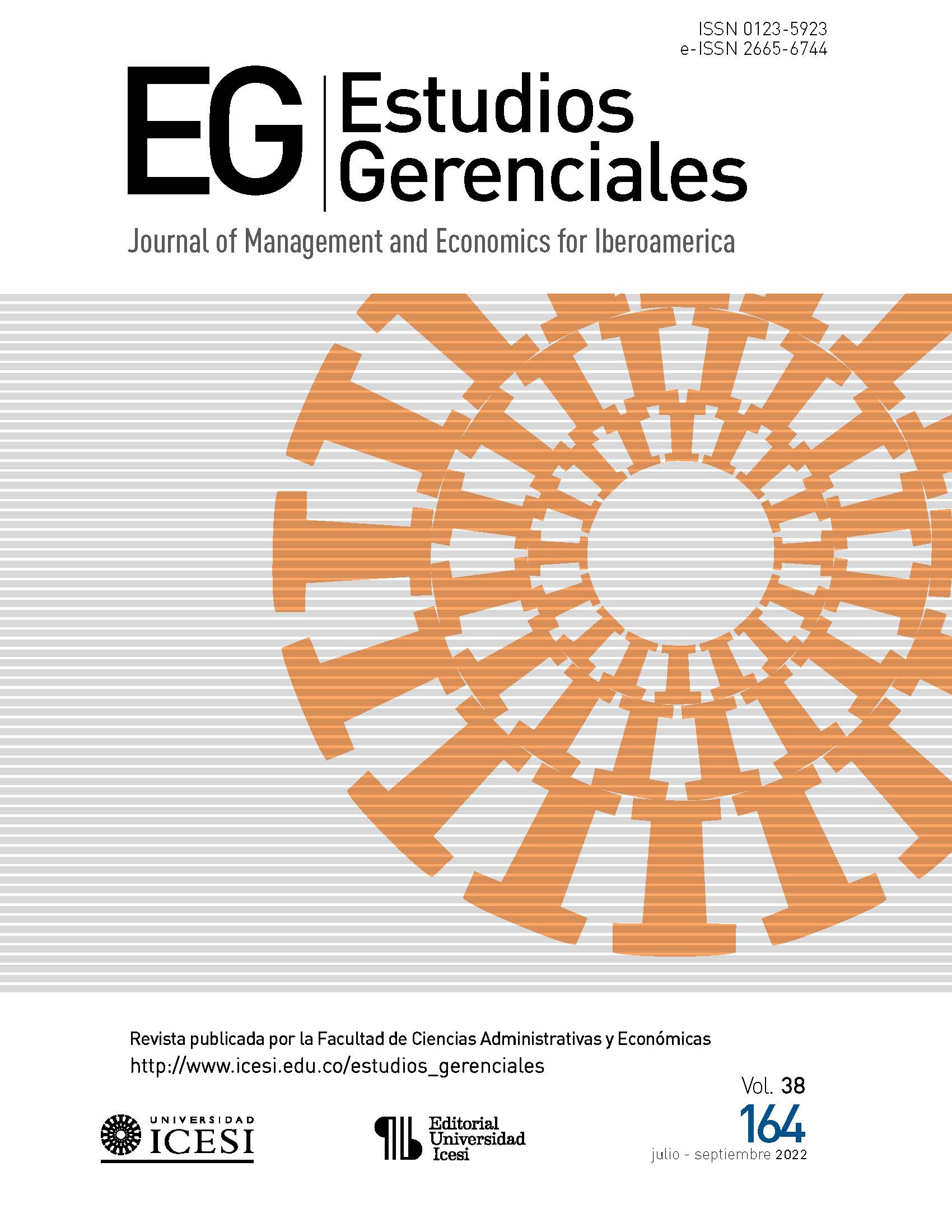Los determinantes del desempeño económico y financiero de las pymes: la función del capital extranjero
DOI:
https://doi.org/10.18046/j.estger.2022.164.5104Palabras clave:
pyme, rendimiento de los activos, propiedad extranjera, modelo de efectos aleatoriosResumen
Las pequeñas y medianas empresas (pymes) son elementos esenciales de la estructura empresarial en Portugal. Debido a sus características intrínsecas, se convierten en un objetivo atractivo para los inversionistas extranjeros, lo que trae consecuencias en el ámbito financiero y económico, particularmente en la rentabilidad. A nivel internacional, el debate sobre su influencia en la rentabilidad es amplio, con una parte que defiende la importancia de la propiedad extranjera en la rentabilidad, y la otra su irrelevancia. La muestra de este estudio está compuesta de 5667 pymes portuguesas de diversos sectores y cubre el periodo de 2014 a 2018. Se usó un modelo de efectos aleatorios para análisis de datos de panel. Además de la muestra completa, también se realizan análisis con la muestra segmentada entre microempresas, pequeñas y medianas empresas y empresas pertenecientes a la industria manufacturera o al comercio al por mayor. Los resultados muestran que el capital extranjero no tiene una influencia significativa en la rentabilidad de las pymes.
Descargas
Referencias
Alonso-Bonis, S., & de Andrés-Alonso, P. (2007). Ownership structure and performance in large Spanish companies. Empirical evidence in the context of an endogenous relation. Corporate Ownership and Control, 4(4B), 206-216. https://doi.org/10.22495/cocv4i4c1p5
Azzam, I., Fouad, J., & Ghosh, D. K. (2013). Foreign ownership and financial performance: Evidence from Egypt. International Journal of Business, 18(3), 232-254.
Bamiatzi, V., Bozos, K., Cavusgil, S., & Hult, G. (2016). Revisiting the firm, industry, and country effects on profitability under recessionary and expansion periods: a multilevel analysis. Strategic Management Journal, 37(7), 1448-1471. https://doi.org/10.1002/smj.2422
Barbosa, N., & Louri, H. (2005). Corporate performance: Does ownership matter? A comparison of foreign- and domestic-owned firms in Greece and Portugal. Review of Industrial Organization, 27(1), 73-102. https://doi.org/10.1007/s11151-005-4920-y
Chari, M., & Shaikh, I. (2017). Defying distance? Cross border acquisitions by emerging economy firms. Thunderbird International Business Review, 59(2), 173-186. https://doi.org/10.1002/tie.21823
Delios, A., & Beamish, P. (2004). Joint venture performance revisited: Japanese foreign subsidiaries worldwide. Management International Review, 44(1), 69. http://www.jstor.org/stable/40835978
Doms, M. E., & Jensen, J. B. (1998). Comparing wages, skills, and productivity between domestically and foreign-owned manufacturing establishments in the United States. In Geography and Ownership as Bases for Economic Accounting. Eds. R. Baldwin et al., NBER, chapter 7, 235-258. https://doi.org/10.1097/COC.0b013e3181917170
Douma, S., George, R., & Kabir, R. (2006). Foreign and domestic ownership, business groups, and firm performance: Evidence from a large emerging market. Strategic Management Journal, 27(7), 637-657. https://doi.org/10.1002/smj.535
Gelübcke, J. P. (2013). The performance of foreign affiliates in German manufacturing: Evidence from a new database. Review of World Economics, 149(1), 151-182. https://doi.org/10.1007/s10290-012-0142-1
Greenaway, D., Guariglia, A., & Yu, Z. (2014). The more the better? Foreign ownership and corporate performance in China. European Journal of Finance, 20(7-9), 681-702. https://doi.org/10.1080/1351847X.2012.671785
Gu, V. C., Cao, R. Q., & Wang, J. (2019). Foreign ownership and performance: mediating and moderating effects. Review of Inter-national Business and Strategy, 29(2), 86-102. https://doi.org/10.1108/RIBS-08-2018-0068
Harris, R., & Robinson, C. (2003). Foreign ownership and productivity in the United Kingdom estimates for U.K. manufacturing using the ARD. Review of Industrial Organization, 22(3), 207-223. https://doi.org/10.1023/A:1023622407571
Hintošová, A. B., & Kubíková, Z. (2016). The effect of the degree of foreign ownership on firms’ performance. Review of Economic Perspectives, 16(1), 29-43. https://doi.org/10.1515/revecp-2016-0003
Jurajda, Š., & Stančík, J. (2012). Foreign ownership and corporate performance: The Czech Republic at EU entry. Finance a Uver - Czech Journal of Economics and Finance, 62(4), 306-324.
Kuntluru, S., Muppani, V. R., & Khan, M. A. A. (2008). Financial performance of foreign and domestic owned companies in India. Journal of Asia-Pacific Business, 9(1), 28-54. https://doi.org/10.1080/10599230801971259
Li, Y., Vertinsky, I. B., & Li, J. (2014). National distances, international experience, and venture capital investment performance. Journal of Business Venturing, 29(4), 471-489. https://doi.org/10.1016/j.jbusvent.2013.08.002
Mallinguh, E., Wasike, C., & Zoltan, Z. (2020). The business sector, firm age, and performance: The mediating role of foreign ownership and financial leverage. International Journal of Financial Studies, 8(4), 79. https://doi.org/10.3390/ijfs8040079
Narayanan, V. (2015). Export barriers for small and medium-sized enterprises: a literature review based on Leonidou’s model. Entrepreneurial Business and Economics Review, 3(2), 105-123. https://doi.org/10.15678/EBER.2018.060203
Nguyen, T., Pham, T., Dao, T., Nguyen, T. N., & Tran, T. (2020). The impact of foreign ownership and management on firm performance in Vietnam. The Journal of Asian Finance, Economics, and Business, 7(9), 409-418. https://doi.org/10.13106/JAFEB.2020.VOL7.NO9.409
Pacheco, L. (2020). The impact of foreign capital on profitability: the case of Portuguese manufacturing SMEs. Int. J. Globalisation and Small Business, 11(4), 391-412. http://repositorio.uportu.pt/jspui/bitstream/11328/3207/1/IJGSB110404%20PACHECO_263382.pdf
Stouraitis, V., Mior Harun, M., & Kyritsis, M. (2017). Motivators of SME initial export choice and the European Union regional effect in manufacturing. International Journal of Entrepreneurial Behavior & Research, 23(1), 35-55. https://doi.org/10.1108/IJEBR-05-2015-0120
Temouri, Y., Driffield, N. L., & Higón, D. A. (2008). Analysis of productivity differences among foreign and domestic firms: Evidence from Germany. Review of World Economics, 144(1), 32-54. https://doi.org/10.1007/s10290-008-0136-1
Trapczynski, P., & Banalieva, E. (2016). Institutional difference, organizational experience, and foreign affiliate performance: evidence from Polish firms. Journal of World Business, 51, 826-842. https://doi.org/10.1016/j.jwb.2016.07.013
Wang, H., Wu, J., Yang, Y., Li, R., & Liu, Y. (2019). Ownership concentration, identity and firm performance: Evidence from China’s listed firms. Emerging Markets Finance and Trade, 55(15), 3653-3666. https://doi.org/10.1080/1540496X.2019.1672042
Yudaeva, K., Kozlov, K., Melentieva, N., & Ponomareva, N. (2003). Does foreign ownership matter. Economics of Transition, 11(3), 383-409. https://doi.org/10.1111/1468-0351.00157
Descargas
Publicado
Número
Sección
Licencia
Los autores de artículos serán responsables de los mismos, y por tal no comprometen los principios o políticas de la Universidad Icesi ni las del Comité Editorial de la revista Estudios Gerenciales. Los autores autorizan y aceptan la cesión de todos los derechos a la revista Estudios Gerenciales, tanto en su publicación impresa como electrónica. Luego de publicado el artículo, puede ser reproducido sin autorización, mencionando autor(es), título, año, volumen, número y rango de páginas de la publicación, y como fuente: Estudios Gerenciales (abstenerse de usar Revista Estudios Gerenciales).








